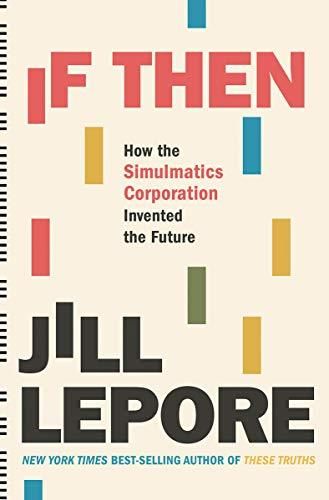Historian, professor and best-selling author, Jill Lepore turns her intelligence, insight and wit to the saga of a seminal data analytics company and how it predicted the future.

Pioneering (Incompetent) Analytics
New Yorker writer Jill Lepore – Harvard professor of American history and host of the podcast The Last Archive – offers a surprisingly gripping story of a tiny company almost nobody remembers: The Simulmatics Corporation, which sold its clients predictions of human behavior deduced from computer simulations.
Its short, often shaky run, Simulmatics played a role in some of the most epochal events of the 1960s, including the election of John F. Kennedy, the Vietnam War and the civil rights movement. Lepore – who can make any subject compelling – details how this long-forgotten firm’s theories and practices reappeared in the predictive analytics of Facebook, Amazon, Cambridge Analytica and Google, among others.
The Observer and O, The Oprah Magazine chose this as a Best Book of 2020. The Financial Times called it, “A beautifully written and intellectually rigorous account of the origins of the science of predictive analytics and behavioral data science.” Booklist said that Lepore, “pulls no punches in criticizing the folly of trying to understand human behavior via algorithm.”
Simulmatics
In 1959, advertising executive Edward L. Greenfield, along with experts in behavioral science, mathematics and computer science, founded the Simulmatics Corporation, which set out to use computers to predict and manipulate human behavior. Lepore clarifies that the company sought to automate the process of modeling and running simulations of how people make decisions.
Before the company went bankrupt in 1970, it completed work for John F. Kennedy’s 1960 presidential campaign, the US Department of Defense, and major United States corporations and ad agencies. Lepore reveals, with some bemusement, that the company failed to produce useful predictions or analyses for most of its clients.
Behavioral Science
The Democrats’ loss in the 1952 presidential election inspired Greenfield to create the Simulmatics Corporation.
The Simulmatics Corporation acted on the proposition that if they could collect enough data about enough people and feed [that data] into a machine, everything, one day, might be predictable, and everyone, every human mind, simulated, each act anticipated, automatically, and even driven and directed.Jill Lepore
Lepore captures the historic moment when Greenfield reasoned that Democrats could embrace the possibilities of computer analytics by entering social and economic data and running simulations showing how voters would respond to a variety of campaign messages.
John F. Kennedy
Greenfield proposed to sort voters into 480 granular types, such as “Midwestern, rural, Protestant, lower income, female.”
Alex Bernstein…was hired by Ed Greenfield to help write a program that would allow candidates to plot out their next moves on a computer, without actually making them, as if politics were a game of chess.Jill Lepore
In May 1959, Simulmatics landed a trial contract with the Democratic Party. Its report on Black, urban, northern voters asserted that Democrats would reclaim the White House if the party was stronger on civil rights. The author maintains that Kennedy followed Simulmatics strategies; northern Black voters proved essential to his victory.
However, an essay in the January 1961 issue of Harper’s magazine about Simulmatics’ role in the election caused a backlash against the company and the idea of computers influencing elections. The Kennedy administration publicly denied its use of Simulmatics, Lepore relates, marveling at its innocence. A public debate ensued about how the use of computers in politics threatened self-government.
Fiasco
Despite the backlash, Lepore discovered that Simulmatics won contracts with multiple clients, including Bristol Laboratories, McCall’s magazine, Nestlé, RCA, Ralston-Purina, Colgate-Palmolive, General Foods, the USDA and Bureau of Public Roads.
In what the author views as a watershed event, The New York Times acquired an IBM computer in advance of the 1962 elections and hired Simulmatics to help analyze results. Lepore depicts a total fiasco. The Simulmatics team’s shortfalls included its inability to run an IBM computer. After other failures, The Times terminated its contract.
Vietnam
Lepore breaks down Simulmatics’ support for US counterinsurgency and Psyops in Vietnam, noting that then-Secretary of Defense Robert McNamara relied on computers and systems analysis.
From its office in Saigon, the company conducted opinion surveys of Vietnamese people and worked on the “Hamlet Evaluation System,” which, Lepore reveals, enabled the military to move South Vietnamese people from their homes into fortified villages.
Lepore is downright amused that the company couldn’t persuade its staff scientists to work in Vietnam, and so it hired inferior employees. Government clients complained that Simulmatics was inept, acting carelessly with classified material and reaching dubious conclusions.
Forgotten
Years after Simulmatics shut down, Lepore notes with surprise, few in Silicon Valley remember it. When its theories about simulating, predicting and manipulating human behavior re-emerged on a mass scale decades later in the world of big data, algorithms and artificial intelligence, Lepore reflects that they seemed brand new.
Simulmatics failed, but not before its scientists built a very early version of the machine in which humanity would in the early 21st century find itself trapped, a machine that applies the science of psychological warfare to the affairs of ordinary life.Jill Lepore
The internet ushered in big data, which companies mined to decode and exploit human behavior – as Simulmatics yearned to do in its own bumbling way decades earlier.
Larger Metaphors
Lepore’s unique, incisive, witty voice and ability to find larger metaphors in almost any aspect of American history makes this a page-turning, illuminating look at how forgotten threads in US history are woven into the tapestry of today. She finds the human drama in Simulmatics’ ambition and failures, and presents them as the pioneering stumbles of an industry as yet unborn, but fighting for a foothold. Lepore’s articulate comparison of Simulmatics’ missteps with the ruthless success of today’s data giants brings resonant insight into their dominance.
Jill Lepore’s other sterling books include These Truths, New York Burning, This America and The Name of War.













